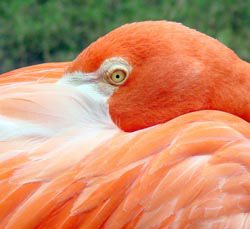
Nutrition




The Caribbean Flamingo obtains its food by filter feeding, like whales do. While feeding, the mouth is open slightly and the tongue is tucked back, creating a negative pressure in the mouth for water and organisms to come in. The bill then closes, the tongue moves forward, and the water gets filtered by the lamellae (comb-like structures covered with fine hairs) that line the inside of the bill. The flamingo's tongue moves back into its original position, and by doing so, forces the water to be released. The food that the flamingo has collected gets forced to the back of the mouth for swallowing by the curvy spines on the back of the tongue, at the same time more water is entering into the mouth.
Once the food is swallowed it is mixed with mucus to lubricate it as it moves down the esophagus to the crop. The crop is the storage spot for the food and also a place for it to soften up before it enters into the stomach. Flamingos regurgitate this softened food up in order to feed it to their babies, it is called "crop milk." Sometimes flamingos even swallow sand or stone which helps the gizzard to grind up shelled organisms like snails that happen to enter the digestive tract.
The Caribbean Flamingo has a closed circulatory system to meet its high energy demands for flying, swimming, and moving around. Its cardiovascular system not only provides oxygen to its tissues and removes waste, but it plays a role in temperature regulation as well. Like a mammal, the flamingo has a heart made up of four chambers (two atria and two ventricles) which receive blood and pump it out to the rest of the body. It cardiovascular system is also made up of two circuits, the pulmonary circuit (carries blood from the heart to the lungs and back) and the systemic circuit (carries blood from to the heart to the body and back). Both of these circuits increase the complexity and efficiency of the avian cardiovascular system.